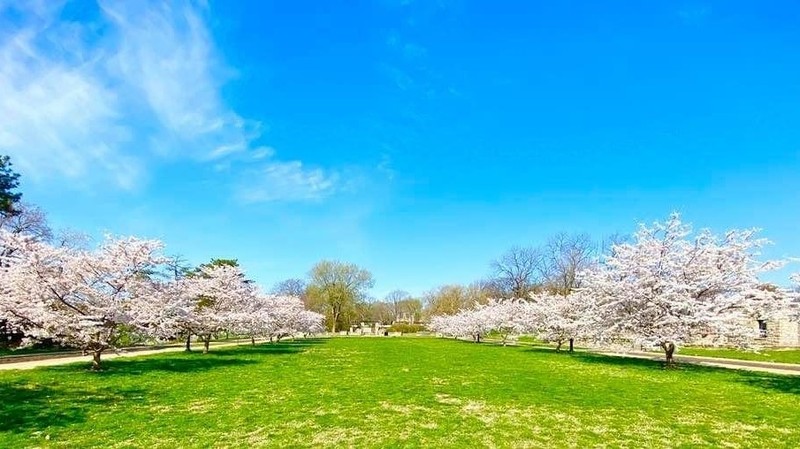Centennial Anniversary of Japan's Gift of Cherry Trees at Loose Park in Kansas City
Introduction
Text-to-speech Audio
Many are aware of the cherry blossoms in Washington, D.C. that bloom each spring thanks to a gift of three thousand cherry blossom trees from Japan in 1912. A hundred years later, Japan marked the centennial of that gift with another sign of peace and friendship between the two nations by gifting these cherry blossom trees to Kansas City and several other U.S. cities. These cherry blossom trees in Loose Park symbolize the relationship between Japan and the U.S. Relations were positive in 1912 when Japan presented the trees to Washington, and despite being enemies in World War II, relations were strong again by the 1950s. The two nations remain allies today.
Images
Cherry Trees in Kansas City's Loose Park

Backstory and Context
Text-to-speech Audio
Marker inscription:
2012 marks the Centennial Anniversary of the gift of 3,000 Flowering Cherry Trees from Japan to the United States. To celebrate this Anniversary, the Japanese Government repeated the gift to cities throughout the United States as a living reminder of 100 Years of
International Friendship.
These trees in Loose Park were presented to the City of Kansas City, Missouri, as a part of that gift.
Dedicated July 18, 2012
Ambassador Ichiro Fujisaki
Consul General Yoshifumi Okamura
Historical Context
Prior to 1852, Japan primarily existed as an isolated country ruled for roughly 250 years by the Tokugawa Shogunate (Shogun). But, in 1852 and 1853, Commodore Matthew Perry and a fleet of steamers and sailing vessels sailed into Tokyo harbor aboard the Susquehanna. The Japanese had yet to witness steamers and other machinery prior to that visit. As a representative of the U.S. government, Perry, in 1852, demanded that Japan enter into trade with the United States, threatening force if Japan did not stipulate. The Japanese knew they could not conceivably defend themselves, so when Perry returned in 1853, they agreed to Perry's demands.
The threat of foreign encroachment set in motion a series of events that resulted in the overthrow of the Shogun and the restoration of the Emperor's rule in 1868, known as the Meiji Restoration. The new, young leaders took the encounter with Perry and subsequent visits from Westerners as a lesson that constitutionalism provided national unity, a well-trained military gave security, and industrialization supplied material strength and modern weaponry.
Thus, the Japanese sought to copy the Western model. To help in that process, Japanese officials visited Western nations, including the United States. Opening their ports, creating military treaties and coalitions, and visiting Western nations created alliances and peaceful relationships (although not without differences and disagreements (such as in situations in Hawaii and China), peaceful relationships. So, despite the U.S. arriving with demands backed by a threat of military force, the Japanese shunned the Shogun and came to embrace the U.S. and Western nations throughout the late nineteenth and early twentieth centuries. So, in 1912, the Japanese sent the U.S. more than 3,000 cherry trees planted in Washington, D.C., to symbolize the bond between the two nations.
World War I started a couple of years after the trees arrived, and both Japan and the U.S. fought on the Allied side. At war's end, Japan's military took control of German bases in China and the Pacific, and the League of Nations (with U.S. Approval) gave Japan mandate over German islands in the Northern Hemisphere. The islands eventually benefited Japan in their strategy of developing a Pacific empire. Meanwhile, tensions between the two nations grew strong by the 1920s, notably when anti-Japanese sentiment in the U.S. (especially in the western states) led to the 1924 policy barring all Japanese immigration to the U.S.
During World War II, Japan's Western model could be seen in its strong nationalism, powerful military (notably its Navy), and desire for expansionism and imperialism. Despite a 1921 treaty among the U.K., France, United States, Japan (and others) intent on limiting naval expansion and greater maritime armament, Japan built a substantial Navy by the 1930s that helped defend an already massive empire spanning 3,000 miles, mainly in the Pacific Ocean; the nation once captivated by Commodore Perry's steamships built a navy able, in their mind, to take on the mighty U.S.
Of course, Japan eventually attacked Pearl Harbor, which brought the U.S. into World War II, and then the U.S. eventually dropped two atomic bombs on mainland Japan at the end of the war. Suffice it to say, the cherry blossom trees that once represented peace seemed like a distant past in the 1940s. But, by the 1950s, relations between the two nations again turned friendly, even weathering an economic battle during the late twentieth century. By 2012, Japan again gifted more trees to more cities, including Kansas City, to celebrate the centennial anniversary.
So, while the two nations have often flexed their military muscles at each other, including fighting a deadly and devastating war against each other, the cherry blossom trees serve as a reminder of the bond and peace enjoyed by the two nations for most of their history. Today, the alliance and friendship (and similarities) between the two culturally different nations seem as strong as ever.
Sources
Asada, Sadao. "The Revolt against the Washington Treaty: The Imperial Japanese Navy and Naval Limitation, 1921-1927." Naval War College Review 46, no. 3 (1993): 82–97. http://www.jstor.org/stable/44637473.
Chusid, Edward Joseph, "The Concurrent Conferences: The Washington Naval Conference and the Far Eastern Affairs Conference of 1922." Master's Thesis. University of Eastern Michigan, 2008. http://commons.emich.edu/theses/188.
Cohen, Warren I. East Asia at the Center: Four Thousand Years of Engagement with the World. New York: Columbia University Press, 2000. http://www.jstor.org/stable/10.7312/cohe10108.
Fischer, William. "Centennial Anniversary of Japan's Gift of Cherry Trees." The Historical Landmark Database. September 7, 2015. https://www.hmdb.org/m.asp?m=88267.
Miller, Jennifer M. "Japan-US Relations." Oxford Research Encyclopedia of American History. April 26, 2019. https://oxfordre.com/americanhistory/view/10.1093/acrefore/9780199329175.001.0001/acrefore-9780199329175-e-616.
Totman, Conrad. Japan Before Perry: A Short History. Berkeley, CA: University of California Press, 1981.
KC Parks: https://kcparks.org/places/loose-park/
